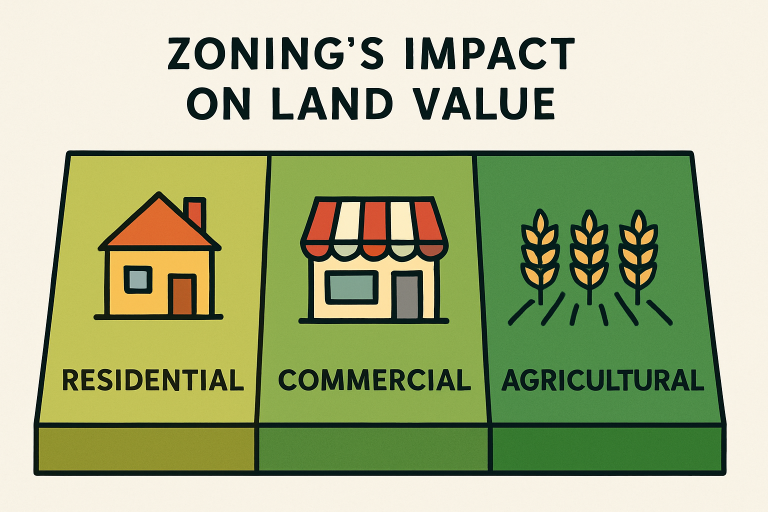Key Takeaways
- Location and accessibility have a significant impact on land value.
- Zoning regulations dictate permissible land uses, which affect its market value.
- Economic conditions and market demand play pivotal roles in valuation.
- Environmental and legal considerations can enhance or diminish land value.
- Appraisal methods, such as the sales comparison and cost approaches, are commonly used.
Understanding how land value is determined is crucial for both buyers and sellers in the real estate market. For those looking to make quick decisions or needing immediate assistance, relying on Fast Buyers in Garland can be a strategic move that simplifies the process and streamlines negotiations. Several important factors influence land valuation, and professionals employ various methods to ensure each property is assessed accurately before any transaction occurs.
Land is more than just earth; it’s defined and shaped by its location, purpose, and potential. Each parcel carries a unique potential based on zoning regulations, access, local economic conditions, and environmental or legal restrictions. Sellers and buyers alike need to understand how these factors intersect, especially as the nuances can mean the difference between a competitive offer and missed opportunities.
The market’s pulse—driven by economic cycles and regional growth—further influences land values, making informed decisions all the more critical. Whether you’re eyeing a bustling future in a growing city or the quiet promise of rural land, knowing how value is measured can ensure deals are fair and well-founded.
Beyond the basic considerations, some owners might find it helpful to quickly explore their selling options or even connect directly with experienced buyers.
Factors Influencing Land Value
Location and Accessibility
This phrase—’Location, location, location”—is more than industry jargon; it’s a fundamental truth in real estate valuation. If you’re looking to sell my lot in TX, land positioned near desirable amenities or landmarks—such as thriving business districts, reputable schools, or major transportation routes—typically commands a premium. For example, in metropolitan areas where demand outpaces supply, land values can skyrocket, reflecting the property’s potential to serve residential, commercial, or mixed-use purposes. Accessibility to public transportation and highways can further enhance the attractiveness of a parcel, making it a magnet for both investors and developers. In contrast, land situated in less accessible, rural, or undeveloped regions generally sees lower market interest and value.
Zoning Regulations
Zoning regulations established by local governments determine how land can be used and developed. Whether a plot is zoned for residential, commercial, industrial, or agricultural use can significantly affect its potential market value. Flexible or high-demand zoning (such as mixed-use or commercial) can increase desirability and price. At the same time, restrictions and environmental overlays can limit what a purchaser or developer can do with the site. Buyers should always review these regulations carefully to avoid costly surprises during or after transactions. According to The New York Times, zoning disputes and regulatory hurdles can delay or derail profitable land deals if they are not understood in advance.
Economic Conditions
Land value doesn’t exist in a vacuum—national and local economic forces influence it. When interest rates are low and unemployment is down, consumer confidence rises, often fueling demand for both residential and commercial land. During economic growth, properties may appreciate rapidly, prompting investors to act quickly. However, in a recession, demand wanes, financing becomes difficult, and land values may drop or stagnate. Monitoring economic trends can help owners and buyers decide the right time for their next move. Forbes highlights that economic indicators such as employment rates and housing starts are excellent predictors of short-term land appreciation or decline.
Environmental and Legal Considerations
Before any sale or purchase, it’s vital to assess the environmental history and legal standing of a property. Soil contamination, floodplain location, or endangered species habitats can all reduce a land parcel’s appeal or even prevent development altogether. Similarly, unclear land titles, easements, or unresolved liens can complicate sales, leading to delays or abrupt changes in valuation. Properties with clean environmental records and clear legal documentation are typically more valuable, serving as safer and more attractive investments for buyers who want peace of mind.
Methods of Land Valuation
Sales Comparison Approach
The sales comparison approach is among the most widely used techniques for evaluating land. By examining recently sold properties with similar characteristics (known as “comparables”), appraisers adjust for factors such as size, location, and unique features to estimate fair market value. This method rests on the “principle of substitution”—the idea that a reasonable buyer will not pay more for a property than a similar, equally desirable alternative.
Cost Approach
The cost approach considers what it would cost to replace or reproduce existing improvements on the land, subtracting depreciation and then adding the value of the raw land itself. It’s especially useful for new construction or unique properties where few or no comparables exist. This approach ensures that values reflect actual investment potential rather than speculative pricing.
Income Approach
Primarily used for land that is or will be income-generating—such as commercial or rental properties—the income approach calculates value based on anticipated earnings. The appraiser estimates potential rental or lease income, deducts expected operating expenses, and applies a capitalization rate to derive the property’s current worth. Investors rely heavily on this method to gauge the profitability of their acquisitions.
Conclusion
Determining land value requires a thoughtful analysis of location, regulatory and environmental context, and prevailing market conditions. By employing industry-standard appraisal methods, buyers and sellers can achieve accurate valuations that support informed, successful real estate transactions. Whether you’re investing in thriving urban centers or evaluating the potential of rural properties, understanding these dynamics is key to maximizing value and minimizing risk in every deal.






